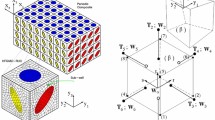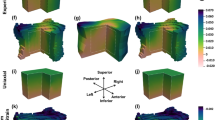Abstract
The interest in automatic volume meshing for finite element analysis (FEA) has grown more since the appearance of microfocus CT (μCT), due to its high resolution, which allows for the assessment of mechanical behaviour at a high precision. Nevertheless, the basic meshing approach of generating one hexahedron per voxel produces jagged edges. To prevent this effect, smoothing algorithms have been introduced to enhance the topology of the mesh. However, whether smoothing also improves the accuracy of voxel-based meshes in clinical applications is still under question. There is a trade-off between smoothing and quality of elements in the mesh. Distorted elements may be produced by excessive smoothing and reduce accuracy of the mesh. In the present work, influence of smoothing on the accuracy of voxel-based meshes in micro-FE was assessed. An accurate 3D model of a trabecular structure with known apparent mechanical properties was used as a reference model. Virtual CT scans of this reference model (with resolutions of 16, 32 and 64 μm) were then created and used to build voxel-based meshes of the microarchitecture. Effects of smoothing on the apparent mechanical properties of the voxel-based meshes as compared to the reference model were evaluated. Apparent Young’s moduli of the smooth voxel-based mesh were significantly closer to those of the reference model for the 16 and 32 μm resolutions. Improvements were not significant for the 64 μm, due to loss of trabecular connectivity in the model. This study shows that smoothing offers a real benefit to voxel-based meshes used in micro-FE. It might also broaden voxel-based meshing to other biomechanical domains where it was not used previously due to lack of accuracy. As an example, this work will be used in the framework of the European project ContraCancrum, which aims at providing a patient-specific simulation of tumour development in brain and lungs for oncologists. For this type of clinical application, such a fast, automatic, and accurate generation of the mesh is of great benefit.
Access this chapter
Tax calculation will be finalised at checkout
Purchases are for personal use only
Similar content being viewed by others
References
Camacho, D.L.A., Hopper, R.H., Lin, G.M., Myers, B.S.: An improved method for finite element mesh generation of geometrically complex structures with application to the skullbase. Journal of Biomechanics, 30, 1067–1070 (1997)
Boyd, S.K., Müller, R.: Smooth surface meshing for automated finite element model generation from 3D image data. Journal of Biomechanics, 39, 1287–1295 (2006)
Taubin, G., Zhang, T., Golub, G.: Optimal surface smoothing as filter design. Proceedings of the 4th European Conference on Computer Vision. 1064, 283–292 (1996)
Liebschner, M.A.K., Kopperdahl, D.L., Rosenberg, W.S., Keaveny, T.M.: Finite element modeling of the human thoracolumbar spine. Spine, 28, 559–565 (2003)
Ulrich, D., van Rietbergen, B., Weinans, H., Rüegsegger, P.: Finite element analysis of trabecular bone structure: a comparison of image-based meshing techniques. Journal of Biomechanics, 31, 1187–1192 (1998)
Viceconti, M., Bellingeri, L., Cristofolini, L., Toni, A.: A comparative study on different methods of automatic mesh generation of human femurs. Medical Engineering and Physics, 20, 1–10 (1998)
Acknowledgments
Funding by the European Union in the framework of the ContraCancrum project (FP7 – IST-223979) is gratefully acknowledged.
Author information
Authors and Affiliations
Corresponding author
Editor information
Editors and Affiliations
Rights and permissions
Copyright information
© 2010 Springer Science+Business Media, LLC
About this paper
Cite this paper
Bardyn, T., Reyes, M., Larrea, X., Büchler, P. (2010). Influence of Smoothing on Voxel-Based Mesh Accuracy in Micro-Finite Element. In: Miller, K., Nielsen, P. (eds) Computational Biomechanics for Medicine. Springer, New York, NY. https://doi.org/10.1007/978-1-4419-5874-7_10
Download citation
DOI: https://doi.org/10.1007/978-1-4419-5874-7_10
Published:
Publisher Name: Springer, New York, NY
Print ISBN: 978-1-4419-5873-0
Online ISBN: 978-1-4419-5874-7
eBook Packages: EngineeringEngineering (R0)




